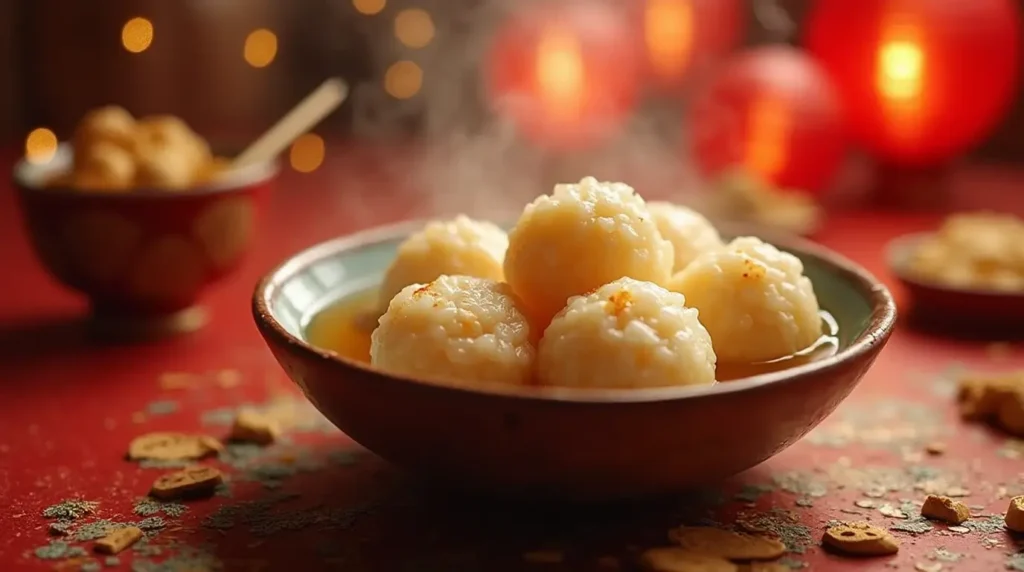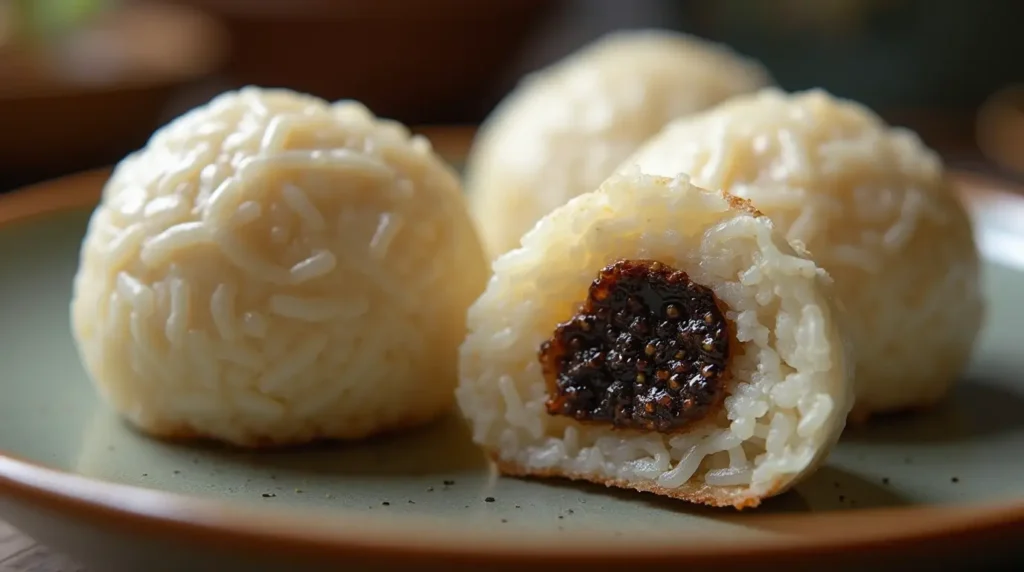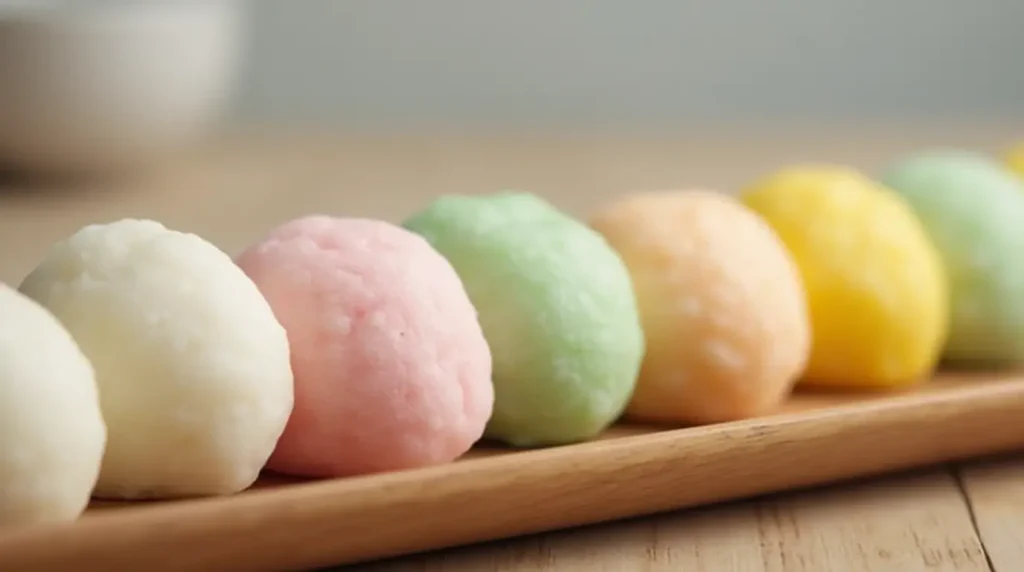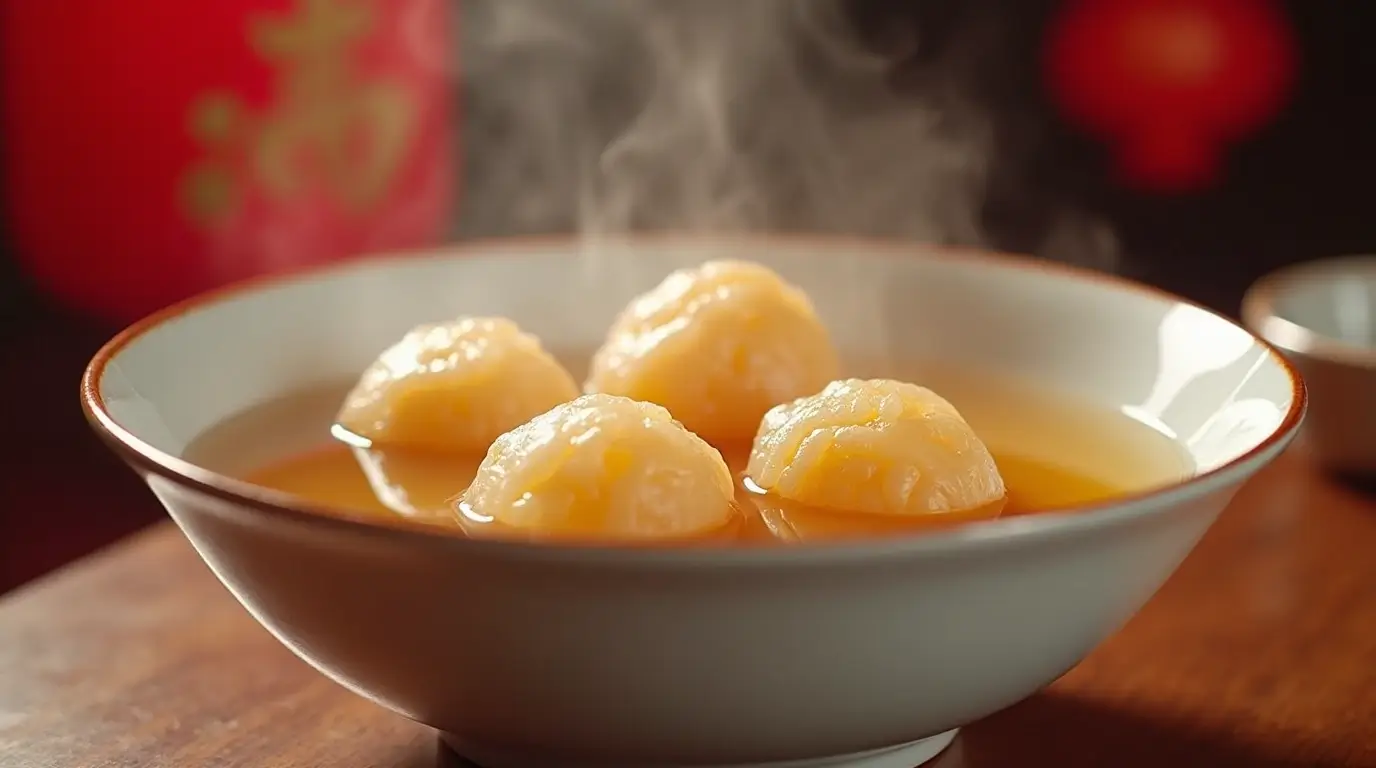Every winter, my grandmother’s kitchen was filled with the warm smell of sweet rice balls. It made our family gatherings magical. These traditional desserts are more than food; they’re a way to connect generations through a simple treat.
Tang yuan are special Chinese desserts that bring families together. They’re made for festivals like the Winter Solstice. With 45 minutes of prep, you can make 15 to 20 rice balls that take you to the heart of Chinese cuisine.
If you’re curious about cooking or want to learn about cultural traditions, this guide is for you. You’ll learn how to make these delicious rice balls. From picking the right ingredients to mastering the technique, you’ll soon be making stunning and tasty sweet rice balls.
Are you ready to start a culinary journey that celebrates flavor and tradition? Your adventure in making authentic tang yuan begins here!
Table of Contents
Understanding Tang Yuan and Its Cultural Significance

Sweet rice balls, or tang yuan, are more than a tasty treat. They hold deep cultural meaning in Chinese traditions. They symbolize family unity and completeness during important festivals.
Traditional Role in Chinese Festivals
The Winter Solstice (Dongzhi) festival on December 21st is a special time for tang yuan. Families come together to enjoy these rice flour delicacies. The number of sticky rice balls eaten has deep symbolic meaning:
- 2 tangyuan: Represents “Good things come in pairs”
- 6 tangyuan: Signifies “Six six great success!”
- 8 tangyuan: Associated with wealth
- 10 tangyuan: Denotes “Perfection!”
- 12 tangyuan: Symbolizes “Fame and fortune!”
Symbolism and Family Unity
Each color of tang yuan has its own meaning. White stands for social connections, red for happiness, and pink for romance. The round shape of these sweet rice balls symbolizes family wholeness and unity.
Regional Variations and Customs
Different regions in China have their own tang yuan traditions. Some like sweet fillings like black sesame or red bean. Others prefer savory versions with pork and chive or chicken and shiitake mushrooms. These variations show the rich culinary diversity across Chinese provinces.
The making and eating of tang yuan is more than just food. It’s a cherished cultural practice that connects generations. It celebrates family bonds.
Essential Ingredients for Sweet Rice Balls
Making delicious glutinous rice balls needs the right ingredients. These ingredients add real flavor and texture to your mochi or daifuku. Choosing the best ingredients is key to making these treats a true culinary delight.
Your main ingredients will include:
- Glutinous rice flour (1 cup)
- Warm water (½ cup)
- Sugar (optional)
For traditional fillings, try these classic options:
| Filling Type | Quantity | Preparation Notes |
|---|---|---|
| Black Sesame | ¼ cup seeds | Toast for 3-4 minutes until fragrant |
| Red Bean Paste | 45g per portion | Smooth, sweet consistency |
| Peanut | 25g | Finely ground |
When making glutinous rice balls, the texture depends on precise ingredient proportions. Chefs say to use a 10:1 ratio of glutinous rice flour to regular rice flour. This ratio gives the perfect chewy texture that mochi and daifuku are known for.
Adding unsalted butter or coconut oil can make your filling richer. The goal is to balance flavors without losing the delicate nature of these sweet rice balls.
Making the Perfect Tang Yuan Dough
Creating the ideal tang yuan dough is key. It’s all about making a soft, elastic dough. This is what makes the rice ball soup so delicious.
Hot Water Dough Method
The hot water method is essential for tang yuan. Here’s how to do it right:
- Use high-quality glutinous rice flour
- Gradually add hot water (around 80°C)
- Mix slowly to prevent lumps
- Knead until smooth and pliable
Achieving Perfect Dough Consistency
Your dough should feel like wagashi sweets – smooth and elastic. Look for these signs:
- Texture should be soft but not sticky
- Dough should spring back when pressed
- No cracking or dry edges
Troubleshooting Dough Challenges
Common dough issues can ruin your tang yuan. If it’s too dry, add warm water a little at a time. If it’s too sticky, add more glutinous rice flour. You want a dough that’s easy to work with.
Practice makes perfect with these Chinese dessert dumplings. With patience and attention to detail, you’ll soon make tang yuan that’s just as good as the traditional ones.
Sweet Rice Balls Filling Variations

Making delicious anko fillings and sesame rice balls is an art. It turns simple dough into a culinary masterpiece. The right filling can make your tang yuan go from ordinary to extraordinary.
Try these traditional and creative fillings to make your sesame rice balls unforgettable:
- Black Sesame Paste: A classic choice with rich, nutty flavors
- Uses 174g of crunchy black sesame butter
- Includes 88g of powdered sugar
- Requires 26g of melted coconut oil
- Red Bean (Anko) Filling: Sweet and smooth texture
- Peanut Butter: Creamy and protein-rich option
- Mung Bean: Traditional and delicate filling
Here are some pro tips for making your fillings:
- Chill fillings for 20 minutes if they become too soft
- Create small balls approximately ½ inch in diameter
- Ensure smooth, consistent texture
| Filling Type | Preparation Time | Flavor Profile |
|---|---|---|
| Black Sesame | 15 minutes | Nutty, rich |
| Red Bean (Anko) | 20 minutes | Sweet, smooth |
| Peanut | 10 minutes | Creamy, mild |
Try different fillings to find your favorite. Tang yuan is all about trying new things and surprising your taste buds.
Cooking and Serving Techniques

Mastering rice flour desserts needs focus on cooking and presentation. The last steps can make your tang yuan dessert stand out.
Proper Boiling Methods
Boiling sticky rice balls requires precision. Follow these steps for the perfect texture:
- Use a large pot with plenty of water
- Bring water to a gentle rolling boil
- Add 6-8 rice balls at a time to prevent sticking
- Cook until balls float to the surface (about 3-4 minutes)
Ginger Syrup Preparation
The traditional ginger syrup makes your rice flour desserts special. Here’s what you need for a rich syrup:
| Ingredient | Quantity |
|---|---|
| Fresh Ginger | 3-inch piece, sliced |
| Brown Sugar | 1/2 cup |
| Water | 2 cups |
Presentation Tips
Enhance your sticky rice balls with these serving tips:
- Serve immediately after cooking for best texture
- Use a white ceramic bowl to showcase the translucent balls
- Drizzle warm ginger syrup generously
- Garnish with fresh mint or toasted sesame seeds
Remember, patience and detail are key to perfect tang yuan. Your homemade rice flour desserts will wow everyone.
Conclusion
Making these glutinous rice treats connects you to a long tradition. Tang yuan is more than a dessert. It’s a celebration of family, culture, and sharing with loved ones.
Your journey in making tang yuan lets you explore flavors and techniques. You can try different fillings and learn a cooking method passed down for centuries. Each bite tells a story of cultural heritage and skill.
Remember, making these treats takes practice. Don’t worry if your first batch isn’t perfect. The beauty of traditional desserts is in their handmade nature and the love you put into them. Store leftovers in the fridge and reheat gently to keep their texture and warmth.
Invite friends and family to share in this culinary adventure. It’s not just about the food. It’s about the cultural experience that brings people together and creates lasting memories. Your homemade tang yuan is a delicious link to a rich culinary tradition.
FAQ
What are tang yuan?
Tang yuan are traditional Chinese sweet rice balls. They are made from glutinous rice flour. They are filled with sweet ingredients like black sesame, peanut, or red bean paste.
They are a popular dessert, enjoyed during winter festivals. These include the Winter Solstice and Lantern Festival. They symbolize family unity and completeness.
Are tang yuan difficult to make at home?
Making tang yuan at home is not hard with practice. The key is getting the dough right. Use glutinous rice flour and hot water.
Also, prepare your filling carefully. Follow step-by-step instructions to make delicious sweet rice balls.
What type of flour should I use for tang yuan?
Use glutinous rice flour for tang yuan. This flour makes them chewy and sticky. Regular rice flour won’t work, so it’s important to use the right flour.
Can I make tang yuan ahead of time?
Yes, you can make tang yuan ahead of time. You can freeze uncooked rice balls on a tray. Then, put them in a freezer bag.
When you’re ready to serve, cook them from frozen. Add a few extra minutes to the boiling time.
What are some traditional fillings for tang yuan?
Traditional fillings include black sesame, peanut, and red bean paste. Black sesame is very popular. It has a rich, nutty flavor that goes well with the sweet rice ball.
How do I prevent tang yuan from sticking together while cooking?
To prevent tang yuan from sticking, follow these steps: – Use a large pot with plenty of water – Stir gently when first adding the rice balls – Avoid overcrowding the pot – Keep the water at a gentle simmer
What serves are traditional with tang yuan?
Tang yuan are traditionally served in ginger syrup or sweet fermented rice soup. These liquids add flavor and warmth. They make the dessert comforting during winter festivals.
Are tang yuan gluten-free?
Yes, tang yuan are gluten-free. They are made with glutinous rice flour, which doesn’t have wheat gluten. But, always check the labels of your fillings to be sure.
Loved Our Recipes? We’d Love to Hear Your Review!
There are no reviews yet. Be the first one to write one.

